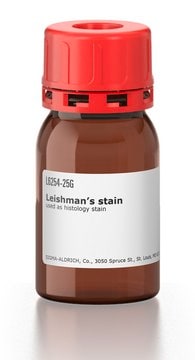Giemsa stain, as defined by the Biological Stain Commission, consists of a polychrome methylene blue and eosin y mixture. When methylene blue undergoes the polychroming process, various homologs of methylene blue are expected to be present. Azure A, Azure B, Azure C, and other homologs may be present. The percentages of the various homologs can and will vary. This product is not tested to determine the identity or concentration of these homologs.
G5637
Giemsa stain
certified by the Biological Stain Commission, powder or crystals
Sinônimo(s):
Azure mixture sicc. Giemsa stain
Selecione um tamanho
Selecione um tamanho
About This Item
Produtos recomendados
Nome do produto
Giemsa stain, certified by the Biological Stain Commission
grau
certified by the Biological Stain Commission
Nível de qualidade
Formulário
powder or crystals
técnica(s)
microbe id | staining: suitable
cor
dark green to very dark green
pf
300 °C (lit.)
solubilidade
ethanol: 1 mg/mL, blue to very deep blue
Absorção
≥0.6 at 647-653 nm in methanol at 0.005 g/L
aplicação(ões)
diagnostic assay manufacturing
hematology
histology
temperatura de armazenamento
room temp
cadeia de caracteres SMILES
[Cl-].CN(C)c1ccc2N=C3C=CC(=[NH2+])C=C3Sc2c1
InChI
1S/C14H13N3S.ClH/c1-17(2)10-4-6-12-14(8-10)18-13-7-9(15)3-5-11(13)16-12;/h3-8,15H,1-2H3;1H
chave InChI
NALREUIWICQLPS-UHFFFAOYSA-N
Procurando produtos similares? Visita Guia de comparação de produtos
Descrição geral
Aplicação
Adequação
Outras notas
Código de classe de armazenamento
11 - Combustible Solids
Classe de risco de água (WGK)
WGK 3
Ponto de fulgor (°F)
Not applicable
Ponto de fulgor (°C)
Not applicable
Equipamento de proteção individual
dust mask type N95 (US), Eyeshields, Gloves
Escolha uma das versões mais recentes:
Já possui este produto?
Encontre a documentação dos produtos que você adquiriu recentemente na biblioteca de documentos.
-
Hello, could you confirm the dye(s) present in G5367? Is it only the pictured compound (I think Azure A) without methylene blue or eosin? Thank you!
1 answer-
Helpful?
-
Active Filters
Nossa equipe de cientistas tem experiência em todas as áreas de pesquisa, incluindo Life Sciences, ciência de materiais, síntese química, cromatografia, química analítica e muitas outras.
Entre em contato com a assistência técnica






